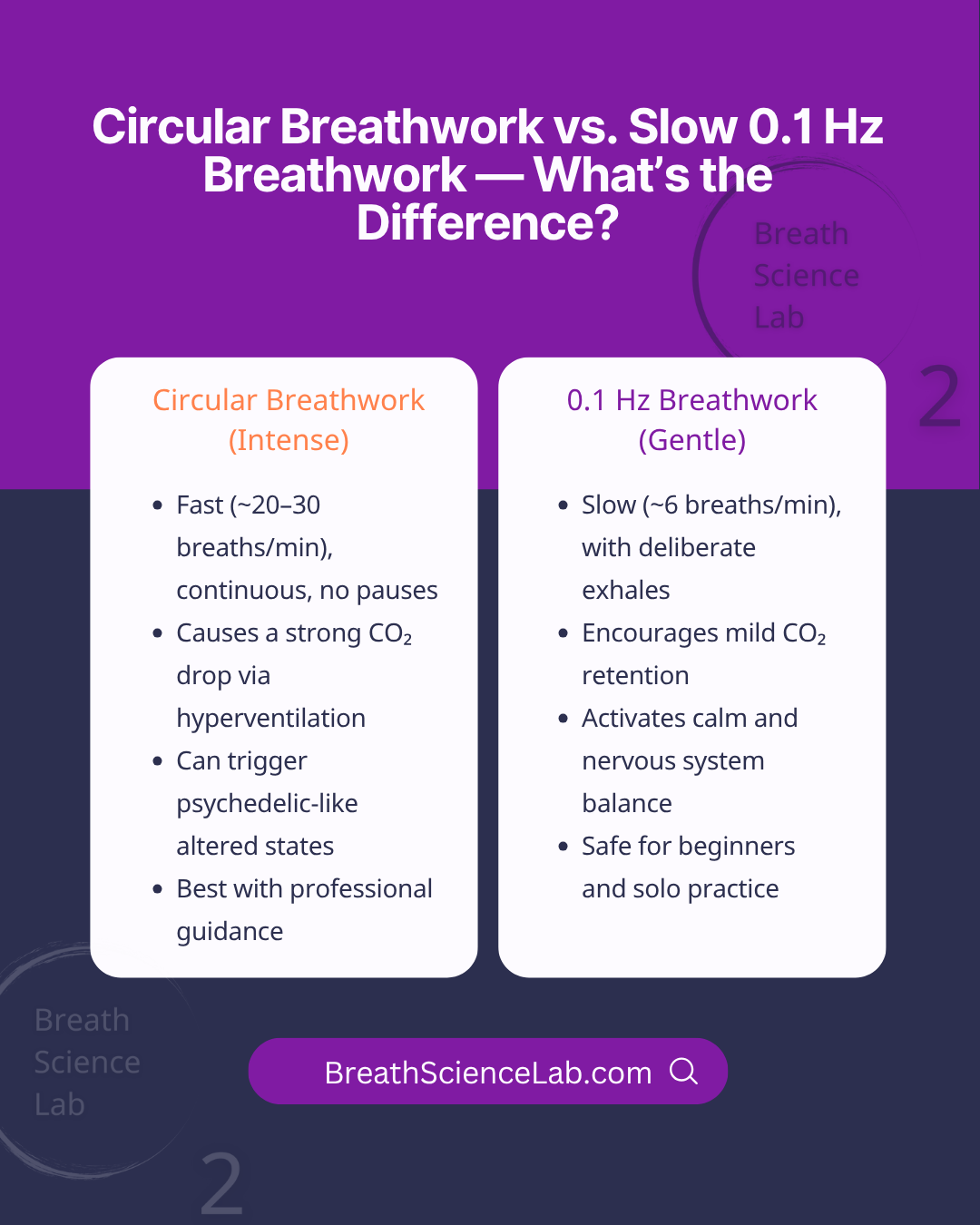How Circular Breathwork Lowers CO₂ to Unlock Altered States of Consciousness - And Why Gentle Breath Might Be Your Best First Step

Breathwork isn’t just a wellness trend. The science is clear: how you breathe can shift your nervous system, change your mood, and even spark altered states of consciousness. But if you’re hoping for fireworks the first time you try circular breathwork, here’s a dose of reality from someone who’s been there.
Why People Search for This
Most people reading this aren’t just curious. You’re searching because you feel stuck, “wired but tired,” anxious, or just… not recovering the way you want. Maybe meditation hasn’t clicked. Maybe you want to understand what breathwork actually does - or you want something research-backed that feels safe to try.
I get it. That’s exactly where I started, and the science (and my own messy, skeptical journey) backs up both fast and gentle approaches.
What the Research Says About Circular Breathwork and CO₂
A 2025 study titled “Decreased CO₂ Saturation During Circular Breathwork Supports Emergence of Altered States of Consciousness” studied people practicing two breathwork styles: Holotropic and Conscious-Connected breathing. Both are about:
- Breathing continuously, no pause between inhale and exhale
- Breathing much faster than normal - about 20 to 30 breaths per minute
- Practicing for 20 to 30 minutes at a time
The researchers found:
“... a reduction in end-tidal CO2 pressure due to deliberate hyperventilation is significantly correlated to ASC onset (r =-0.46; p<0.001)”
(Decreased CO₂ saturation during circular breathwork supports emergence of altered states of consciousness, p. 1)
Bottom line: rapid, connected breathing can push your body and mind into deeply altered states, but it’s not magic for everyone - and it’s definitely not for every nervous system.
What It’s Actually Like to Try These Breathing Techniques
Let’s be real - when I first tried circular breathwork, I was hoping for some crazy, life-changing experience. You know, the stuff you read about: big breakthroughs, emotional releases. What really happened? Not much. I felt a little tingly at the end, maybe a bit of a shift in my body, and sure, I was more relaxed. But honestly? I kept dozing off. I’d nod out for a few seconds, snap back, then drift again. So much for a psychedelic journey.
On the flip side, I actually tried the slower, 0.1 Hz breathwork approach first — thanks to HeartMath’s heart coherence meditation. That’s about 6 breaths per minute, which the science now says can help reduce stress and anxiety. For me, my heartbeat felt stronger, like my whole chest was syncing up with it. I’d feel really calm and sometimes drowsy. Not a fireworks show - but real. Maybe you’ll relate.
And that “wired but tired” feeling? Oh yeah, been there. There were times I just couldn’t meditate or relax, no matter what. What worked was a quick breath-of-fire and alkaline breathing combo I found on YouTube (here’s the link). It’s 20 seconds of breath of fire, double speed, switch to alkaline breathing for 20 seconds, double speed, inhale and hold, exhale and hold. Three rounds. That breathwork left me feeling alive and actually happy - in the moment, not just later.
If nothing else works, I go to the Wim Hof Method. It’s backed by science, and honestly, sometimes I’ll do Wim Hof before HeartMath just to “open the door” - and suddenly I’m able to get heart coherence where I couldn’t before. Night and day difference. (If you use the HeartMath app, you’ll get it.)
As for community? I’m mostly a lone wolf-except for my twin brother in Costa Rica. He’s the only one in my family who’s also deep into breathwork. We swap techniques, compare experiences, and keep each other going, even from thousands of miles apart. Honestly, that’s part of why I blog-to connect with others who get it.
Huge Shout Out:
Before I move on, I have to give a massive thank you to Breathwork Beats on YouTube and Wim Hof himself. Breathwork Beats’ routines-especially that breath of fire/alkaline combo-were absolute game-changers for me. I couldn’t believe how quickly I felt more alive and happy. And Wim Hof? His method and the research behind it have transformed my recovery, my health, and my mindset.
If you’re new, seriously: check them both out. These are not just YouTube channels or techniques-they’re part of why I’m still sane and thriving.
Circular Breathwork vs. Slow 0.1 Hz Breathwork — What’s the Difference?

Personal insight: For most people, especially if you’re starting out or you’re wired but tired, the slower approach is not only safer but often more effective at helping you actually feel better. Save the wild stuff for when you have a safe setting and real support.
How to Practice Breathwork Safely (For Real Life)
- If you’re curious about circular breathwork: seek a trained facilitator or group - don’t go solo until you know how your body responds.
- If you’re new, anxious, or want steady results: start with the 0.1 Hz Breath (5 seconds in, 5 seconds out for 2-5 minutes).
- Check out the Breathwork Readiness Checklist: it’ll help you figure out what your nervous system is ready for (and what to skip for now).
Tip: If you want to meditate but can’t sit still, do a round of Wim Hof or breath-of-fire first - it’s often the missing key.
Why This Science Matters for You
This study is proof that breathwork isn’t woo woo - it’s biology, psychology, and self-care all rolled into one. The takeaway? You can shift your mood, energy, and even immune system, just by how you breathe. You don’t need fancy gadgets, and you don’t need to force calm. You can breathe your way there, at your own pace.
Ready to Start?
- Try my Parasympathetic Reset protocol in this post for a gentle, science-backed start.
- Use the Breathwork Readiness Checklist to personalize your approach.
- When you’re ready, experiment - and trust your own results more than the hype.
Breathe slow, breathe real, and don’t let anyone tell you what you should feel. This is your journey - lone wolf or not.
I’d love to hear from you: What breathwork practices have worked for you? Drop your story or favorite technique in the comments-let’s help each other out.

